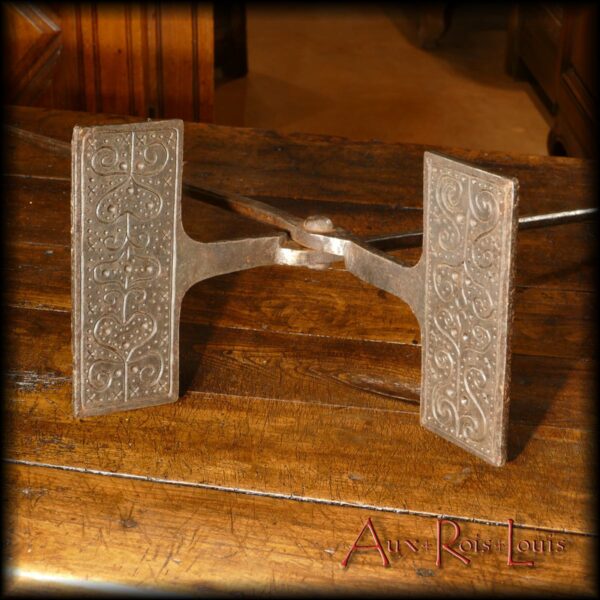Larch wood table for cracking walnuts (énoisage) – 19th century – Haute-Loire – [MP051]
A thick larch plateau from the foothill forests of Velay and, on each corner, kinds of amazing little hollows…Here we have a genuine “énoisage” table, perfectly designed to wedge the walnuts when snapping them with the mallet called “tricote”, to prevent the nuts from rolling to the other end of the table.

![Larch wood table for cracking walnuts (énoisage) – 19th century – Haute-Loire – [MP051]] This authentic "paysan" rural piece of furniture, from around the foothills of Velay, is a testimony of the spirit of friendly mutual assistance among neighbours who went to one another's homes to do the "énoisage" all together during the late evening "velhada", sometimes improvising friendly little dances to the sound of clogs, "cabrettes" and accordions.](https://www.aux-rois-louis.com/wp-content/uploads/2023/10/MP051_P1670111-600x600.webp)
![Peasant Water Jug in Glazed Terracotta – 19th Century – Auvergne – [PA078] This glazed terracotta water jug comes from a countryside workshop in Brioude, Haute-Loire, France. This type of Auvergnat pottery workshop operated only in winter when farmers were free from fieldwork. The clay is red due to its natural iron oxide content. This raw clay was grogged, meaning it was mixed with river sand and crushed fired clay.](https://www.aux-rois-louis.com/wp-content/uploads/2023/12/PA078_P1670085-600x600.webp)
![Inseparable salt and flour boxes in walnut - 18th century - Provence - [MP025]](https://www.aux-rois-louis.com/wp-content/uploads/2021/11/MP025_153x900-600x600.jpg)

![Kettle, pie dish and decaliter jug in red copper – 18ᵉ century – South West – [MP035] [MP036] [MP037] Three copper containers of exceptional size: an enormous kettle, the matching pie dish and an equally imposing pitcher. All are in red copper and date from the 18th century, a period during which they were manufactured using the same processes in the South West of France.](https://www.aux-rois-louis.com/wp-content/uploads/2022/10/ME035-036-037_426-600x600.webp)
![Oak farm table – 18ᵗʰ century – Cantal – [MP031] Oak farm table – 18ᵗʰ century – Cantal – [MP031]](https://www.aux-rois-louis.com/wp-content/uploads/2022/08/MP031_093-600x600.webp)

![Imperial oil jug – 19ᵗʰ century – Quercy – [PA072]](https://www.aux-rois-louis.com/wp-content/uploads/2022/04/PA072_P1660219x1200-600x600.jpg)
![Walnut sideboard – 18ᵗʰ century – South-West – [MP030]](https://www.aux-rois-louis.com/wp-content/uploads/2022/04/MP030_740-600x600.jpg)
![Terracotta ham pot – 19th century – Charente – [PA067]](https://www.aux-rois-louis.com/wp-content/uploads/2022/02/PA067_715-600x600.jpg)
![Two oil jugs - late 18th century early 19th century - Lot Valley, Quercy - [PA062] [PA063]](https://www.aux-rois-louis.com/wp-content/uploads/2021/12/PA062-63_P1650160-600x600.jpg)
![Walnut pantry cabinet - 19th century - Provence - [MP026]](https://www.aux-rois-louis.com/wp-content/uploads/2021/11/MP026_P1650178x900-600x600.jpg)

![Jam cabinet in cheery – late 18th century – Périgord – [MP023]](https://www.aux-rois-louis.com/wp-content/uploads/2021/11/MP023_084x900-600x600.jpg)
![Two water jugs – 19th century – Les Landes – [PA060] [PA061]](https://www.aux-rois-louis.com/wp-content/uploads/2021/11/PA060_61_099x900-600x600.jpg)
![Three water jugs – 19th century – Périgord – [PA055] [PA056] [PA057]](https://www.aux-rois-louis.com/wp-content/uploads/2021/10/PA055-56-57_P1600970-600x600.jpg)
![MP022_P1600984 Beech butcher's block - early 20th century - [MP022]](https://www.aux-rois-louis.com/wp-content/uploads/2021/08/MP022_P1600984-600x600.jpg)

![MP019_P1600496 Vaisselier dresser-drainer in cherrywood – 19ᵗʰ century – South West – [MP019]](https://www.aux-rois-louis.com/wp-content/uploads/2021/04/MP019_P1600496-600x600.jpg)
![MP017_P1600257 Oval walnut cellar table – 18ᵗʰ century – Lot – [MP017]](https://www.aux-rois-louis.com/wp-content/uploads/2021/02/MP017_P1600257-600x600.jpg)
![ME043_P1600159 Louis XV style “homme-debout” in walnut - 18ᵗʰ century - Périgord - [ME043]](https://www.aux-rois-louis.com/wp-content/uploads/2020/11/ME043_P1600159-600x600.jpg)

![Louis XIII kitchen cupboard 17ᵗʰ century – Haute‑Loire Louis XIII kitchen cupboard 17ᵗʰ century – Haute‑Loire – [MP002]](https://www.aux-rois-louis.com/wp-content/uploads/2022/07/N17_P1470819-600x600.webp)